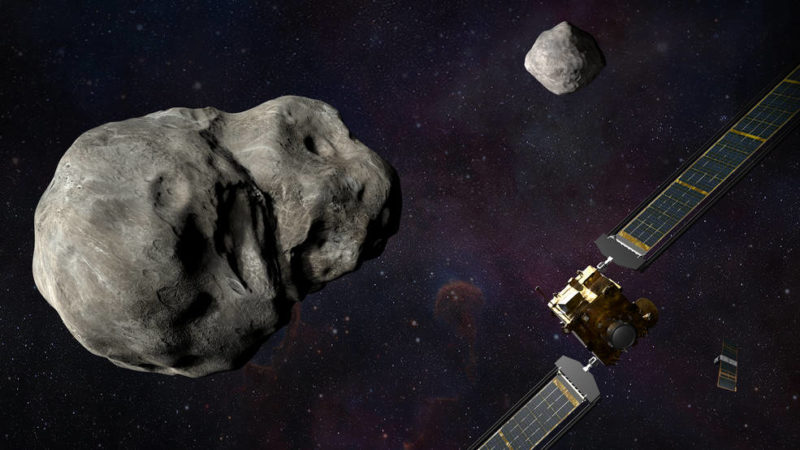
A three-times-flown Falcon 9 booster is set to rise from Space Launch Complex (SLC)-4E at Vandenberg Space Force Base, Calif., no sooner than 10:21 p.m. PST Tuesday (1:21 a.m. EST Wednesday), carrying the ambitious Double Asteroid Redirection Test (DART) mission. Jointly run by NASA and the Johns Hopkins University Applied Physics Laboratory (JHU/APL) in Laurel, Md., DART will embark on a ten-month voyage to intentionally crash a probe into the double asteroid system 65803 Didymos/Dimorphos to evaluate the effectiveness of a kinetic impactor in changing the orbital characteristics of a Near-Earth Object (NEO).
But don’t expect any Bruce Willis-style heroics from DART, for mission planners anticipate the impact to induce—at most—only a ten-minute time change to tiny Dimorphos’ orbital path around its larger companion.
“DART is a critical step in demonstrating we can protect our planet from a future asteroid impact,” said Andy Cheng, a DART investigation co-lead at JHU/APL. “Since we don’t know that much about their internal structure or composition, we need to perform this experiment on a real asteroid. With DART, we can show how to protect Earth from an asteroid strike with a kinetic impactor by knocking the hazardous object into a different flight path that would not threaten the planet.”
“DART will be the first demonstration of the “kinetic impactor” technique, in which a spacecraft deliberately collides with a known asteroid at high speed to change the asteroid’s motion in space,” added Lindley Johnson, NASA’s Planetary Defense Officer.
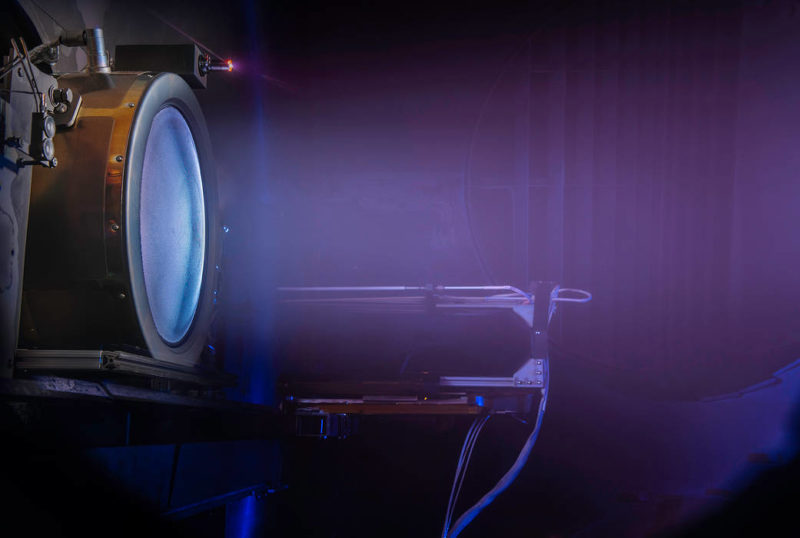
“This technique is thought to be the most technologically mature approach for mitigating a potentially hazardous asteroid,” continued Mr. Johnson, “and it will help planetary defense experts refine asteroid kinetic impactor computer models, giving insight into how we could deflect potentially dangerous near-Earth objects in the future.”
Tiny asteroids impact Earth on a regular basis, disintegrating harmlessly in our planet’s thick atmosphere, with larger objects posing a much rarer threat. Ninety-three percent of objects bigger than a half-mile (0.8 kilometers) across—or sufficiently large as to create global effects—are already the focus of NASA’s ground-based search for potentially hazardous NEOs. In 2016, the agency established its Planetary Defense Coordination Office (PDCO) to find, track and characterize these lurking dangers in deep space.
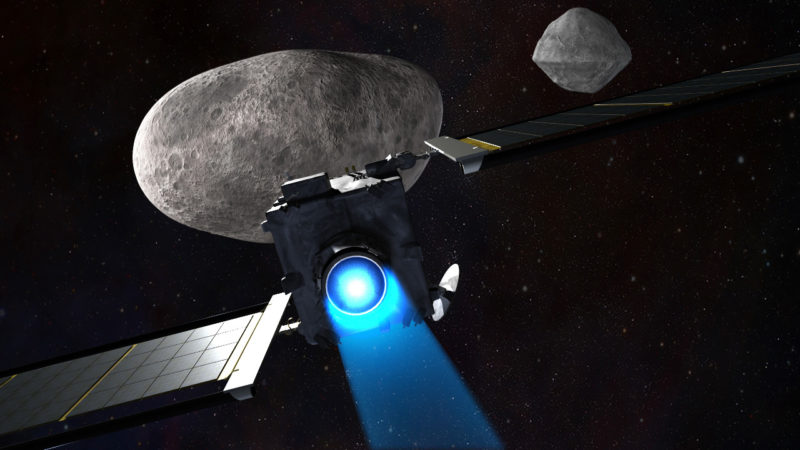
It goes without saying that the asteroid selected as DART’s target is not on a direct course to hit Earth, but it remains the case that of the estimated 25,000 asteroids thought to occupy the Solar System only a handful (some 8,000 or so) are definitively known and their orbits routinely tracked. And whilst no known asteroid bigger than about 460 feet (140 meters) has a significant chance of hitting our home planet for the next hundred years, only about 40 percent of those potential impactors have been found so far.
DART’s destination is a “binary” system, comprising the silicate-rich asteroid Didymos, which measures almost a half-mile (0.8 kilometers) across, and its smaller companion, Dimorphos, at just 525 feet (160 meters) in diameter.
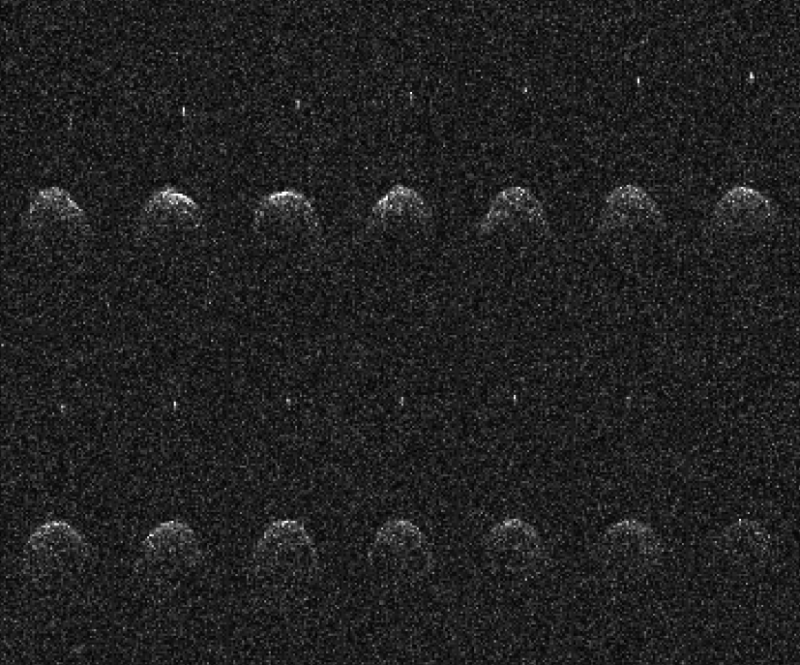
Its orbital path carries it as far as 2.3 Astronomical Units (AU), some 214 million miles (344 million kilometers) from the Sun, but when DART arrives next fall the Didymos/Dimorphos system will achieve its closest approach to Earth, coming within 6.8 million miles (11 million kilometers) of us. And as an eclipsing binary asteroid, as viewed from Earth, it presents itself as an ideal candidate for observations of its changeable brightness and orbital characteristics.
Didymos was discovered back in April 1996, via ground-based observations using the 2.9-foot (0.9-meter) optics at Kitt Peak National Observatory (KPNO), near Tucson, Ariz. Its companion, Dimorphos—which received the nickname “Didymoon” for a while—was found in November 2003, but received its formal name only in June 2020.
“Upon discovery, asteroids get a temporary name until we know their orbits well enough to know they won’t be lost,” said astronomer Andy Rivkin, a DART investigation co-lead at JHU/APL. “Once the Didymos system was identified as the ideal target for the DART mission, we needed to formally distinguish between the main body and the satellite.”
Over almost two decades, the system has been closely monitored and its orbital parameters precisely tracked, revealing that Dimorphos orbits Didymos in a roughly circular path every 11.9 hours. Indeed, the distance between the two objects is only about 0.7 miles (1.2 kilometers). It is expected that by impacting DART into Dimorphos and slightly nudging its path around Didymos, this will cut its orbit by about ten minutes to 11.83 hours.
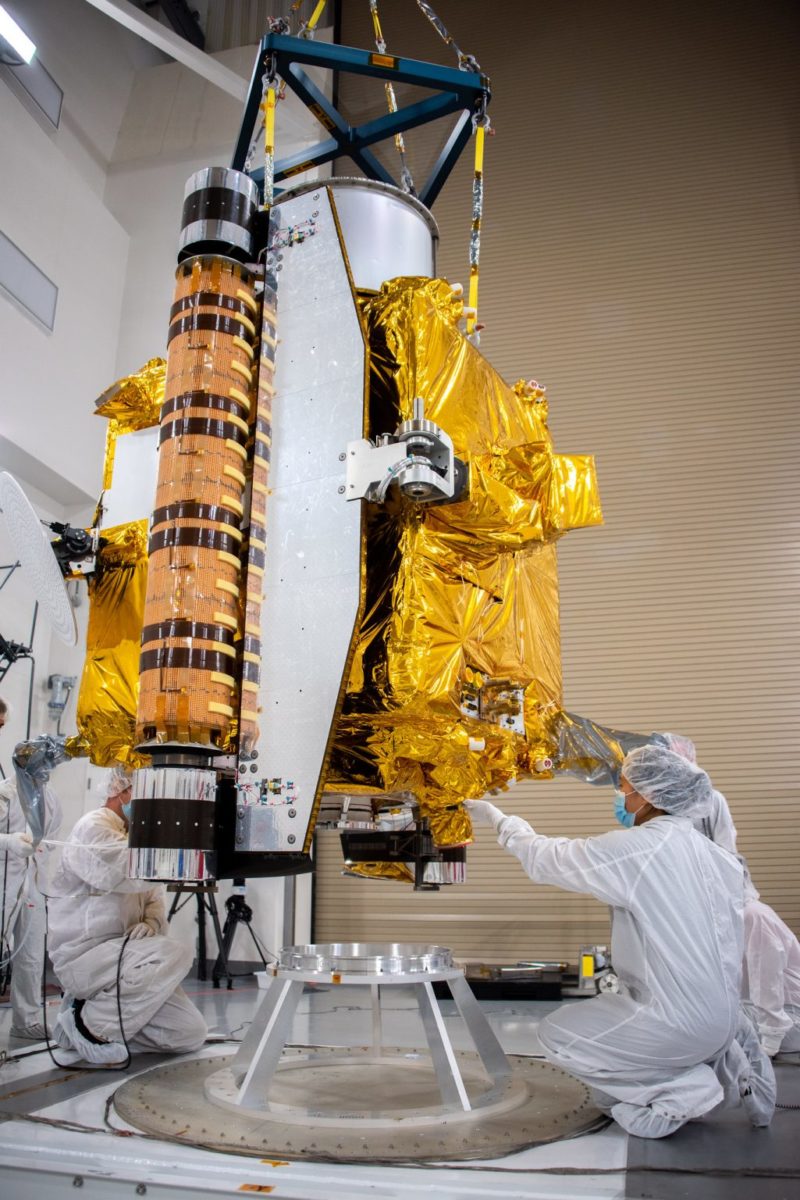
Although very little is known of Dimorphos’ nature, its larger companion is thought to be silicate-rich and shares compositional similarities with many other asteroids. As a potential target for an impactor mission, Didymos/Dimorphos was described as “the perfect natural laboratory” by Tom Statler, DART’s program scientist at NASA Headquarters in Washington, D.C.
Four years ago, in June 2017, DART was approved by NASA to move from conceptual development into its preliminary design phase and from thence into final design and fabrication beginning in August 2018. Built and operated by JHU/APL, the mission received its rocket in April 2019, when NASA awarded a launch services contract worth $69 million to SpaceX for a Falcon 9 booster.
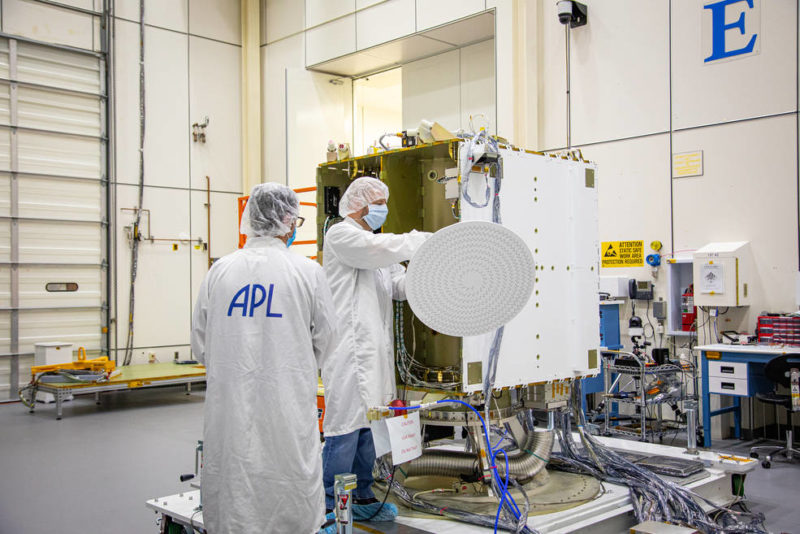
At the time of the launch services award, DART was set to launch in the summer of 2021, with an estimated arrival in the neighborhood of Didymos/Dimorphos in late September to early October 2022. The project sailed through its multi-day Critical Design Review (CDR) in September 2019 and its Mission Operations Review (MOR) the following September, during which time the spacecraft, its trajectory, mission requirements, systems, schedule and costs were put under the microscope.
The way was thus clear to begin assembling DART itself, a cube-shaped box of a machine which weighs around 1,480 pounds (670 kilograms) and is dominated by its two large solar arrays “wings”, covering 240 square feet (22 square meters), and the NASA Evolutionary Xenon Thruster-Commercial (NEXT-C) ion engine.
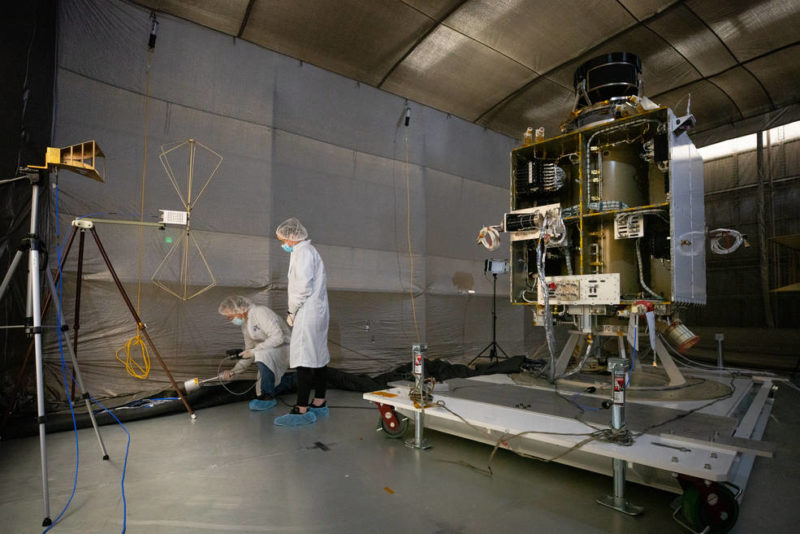
In November 2019, the first of its Guidance, Navigation and Control (GNC) sensors was delivered and in March of last year DART formally moved into integration and testing. Its hydrazine-fed chemical propulsion system and NEXT-C engine, installed by Aerojet Rocketdyne at its facility in Redmond, Wash., were attached to DART’s primary structure and the complete “package” was returned to JHU/APL in May 2020.
This laid the groundwork for the addition of wiring harnesses and DART’s primary observing instrument, the Didymos Reconnaissance and Asteroid Camera for Optical Navigation (DRACO). The latter is modeled closely upon New Horizons’ Long-Range Reconnaissance Imager (LORRI).
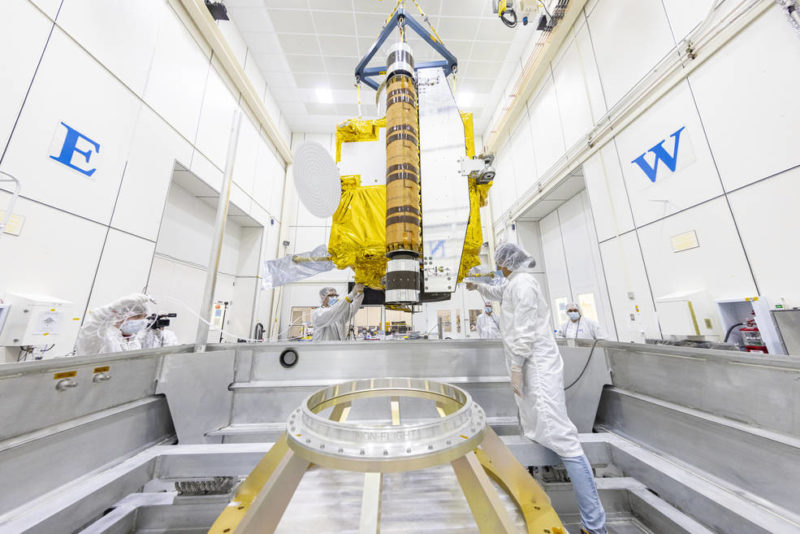
Earlier this year, the spacecraft entered a period of environmental testing to ensure that it could survive the rigors of a Falcon 9 launch and the extreme thermal and vacuum conditions of an extended voyage far beyond Earth. But in February 2021, NASA abandoned DART’s “primary” launch window—which ran from 21 July through 24 August—and opted instead for the “secondary” window, which extends for 84 days from 24 November until next 15 February.
The delay came after a risk assessment to DART’s project schedule, which raised concerns about the readiness of DRACO and the Roll-Out Solar Arrays (ROSAs) which will furnish the spacecraft with electrical power. Both components had suffered supply-chain impacts following the worldwide march of the COVID-19 coronavirus pandemic.
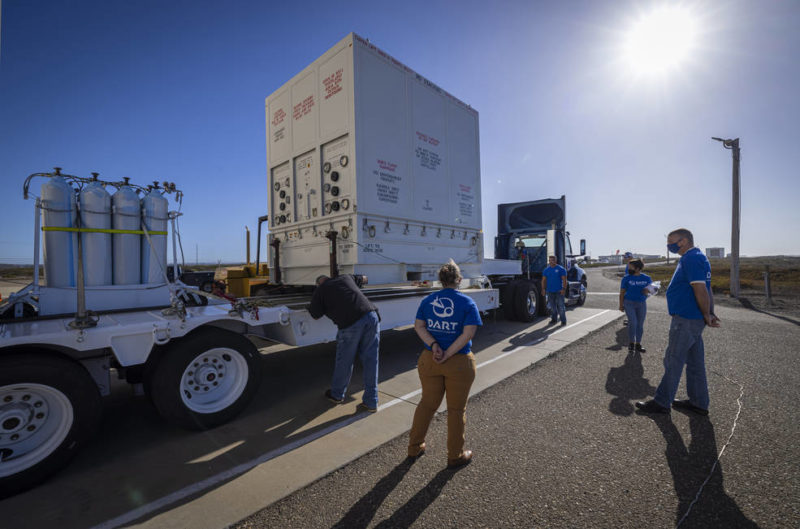
During the summer, DRACO and the ROSAs were installed; the latter, housed in gold cylindrical canisters, will each unfurl to a length of 28 feet (8.5 meters) and provide up to 6.6 kilowatts of power for spacecraft operations . As for DRACO, its narrow-angle telescope, Complementary Metal Oxide Semiconductor (CMOS) detector and on-board image processor will determine the relative position of Dimorphos and support DART’s Small-Body Maneuvering Autonomous Real-Time Navigation (SMARTNav) system.
It is expected that DRACO’s images will be transmitted back to Earth in real time as the spacecraft hits Dimorphos at a velocity of 4.1 miles per second (6.5 kilometers per second). The instrument’s final images, collected just two seconds prior to impact, are expected to resolve the surface at a level of 1.2 inches (3 centimeters) per pixel.
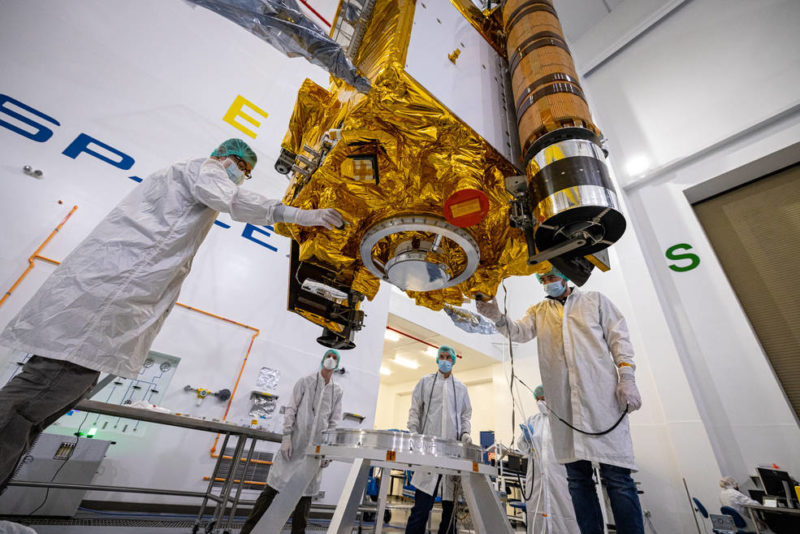
Elsewhere, in September, the Light Italian CubeSat for Imaging Asteroids (LICIACube), provided by the Italian Space Agency (ISA), was installed onto DART. This 6U-class CubeSat weighs just 31 pounds (14 kilograms) and will be spring-ejected from the main spacecraft about ten days before reaching the Didymos/Dimorphos system.
LICIACube will utilize its on-board propulsion system to slightly offset its trajectory, in order that it will pass Dimorphos about three minutes after DART hits the tiny asteroid. Its two optical cameras—the LICIACube Unit Key Explorer (LUKE) and the LICIACube Explorer Imaging for Asteroid (LEIA)—will gather scientific data and enable close-range observations of the ejecta plume and a new impact crater formed by DART.
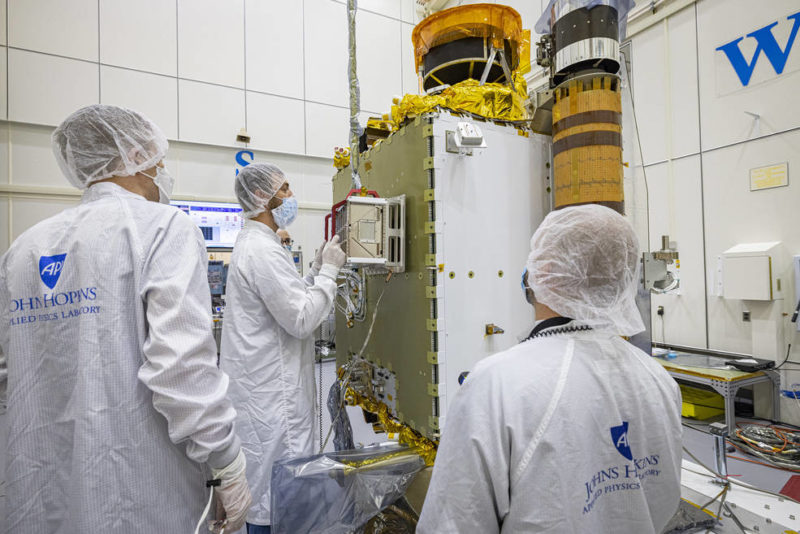
Late in September, DART departed JHU/APL aboard a semi-trailer truck, bound for Vandenberg Space Force Base, Calif., arriving at the launch site on the afternoon of 2 October. It was initially moved to Vandenberg’s Astrotech Space Operations Facility and from there to the SpaceX Payload Processing Facility on 26 October, where its fuel tank was loaded with about 110 pounds (50 kilograms) of hydrazine propellant for in-space maneuvers and attitude-control functionality.
DART carries 12 hydrazine thrusters, each of which produces a thrust of about 0.2 pounds (90 grams). Meanwhile, the 130 pounds (60 kilograms) of xenon for the NEXT-C ion engine had been previously loaded aboard DART whilst in Maryland. On 11 November, the spacecraft was attached to its launch vehicle payload adapter, which measures only 24 inches (60 centimeters) in diameter.
In the meantime, the Falcon 9 booster is entering the final phase of preparedness for its own flight. Alongside a brand-new second stage, the previously-used B1063 core stage—a veteran of two prior missions—underwent a customary Static Fire Test of its nine Merlin 1D+ first-stage engines last Friday. Weather conditions for overnight Monday/Tuesday are predicted to be 90-percent favorable, with a slight risk of out-of-limits winds.
B1063 first saw service last November, when she delivered NASA’s Sentinel-6A Michael Freilich radar-altimetry oceanography satellite aloft from Vandenberg. She then headed to the East Coast, where she completed her second duty last May, when she lifted 60 Starlink low-orbiting communications satellites from Cape Canaveral Space Force Station, Fla. Her first two launches saw B1063 land safely on solid ground at Vandenberg’s Landing Zone (LZ)-4 in November and on the deck of the Autonomous Spaceport Drone Ship (ASDS) in May.
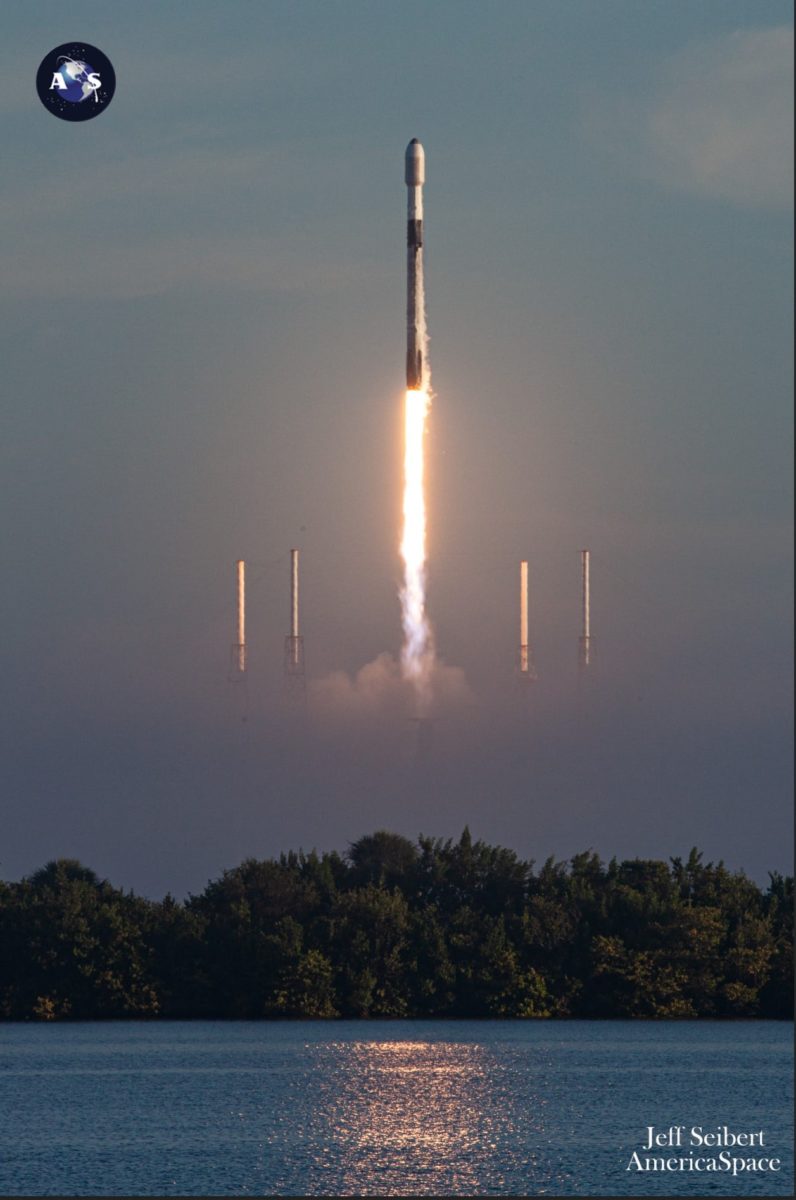
With tomorrow’s launch, SpaceX will equal with 2020 its “personal best” of 26 Falcon 9 missions in a single calendar year. Last December, the Hawthorne, Calif.-headquartered organization wrapped up a banner year with 26 launches accomplished using only 11 booster cores; by contrast, tomorrow’s scheduled launch of DART will have achieved the same number of flights with only nine boosters.
And with two Starlink missions, NASA’s Imaging X-ray Polarimetry Explorer (IXPE), Turkey’s powerful Türksat 5B communications satellite and the CRS-24 Cargo Dragon bound for the International Space Station (ISS) in the next six weeks, it can be expected that 30 or more Falcon 9s will have taken flight by the time the New Year’s Eve midnight bell tolls out 2021.




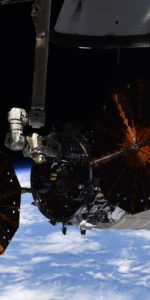
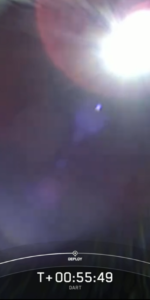
The problem of asteroid hazard is very serious and will always hang over humanity like the sword of Damocles. It is quite natural when everyone wants to hope for the success of space missions aimed at preventing this danger. But when such a mission is conceived with violating the law of physics (the impossibility of momentum transferring to the target as a whole during an perfectly inelastic collision) and astronomical data (the crumbly internal structure of the near-Earth asteroids in the presence of large vacuum voids, which are able to completely damp the shock wave already near the collision zone), then without sufficient theoretical and model-experimental substantiation the probability of its success will be extremely low.